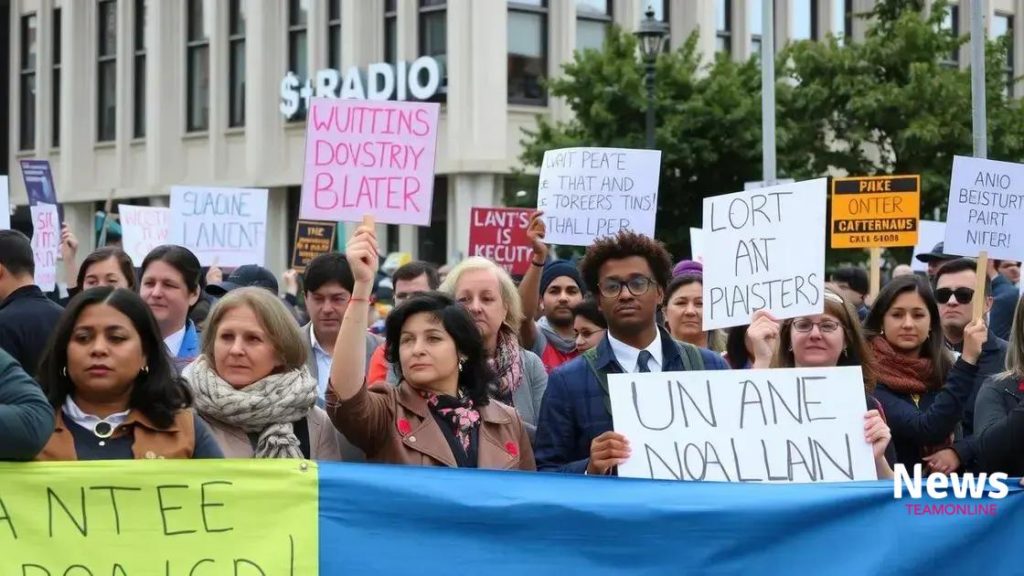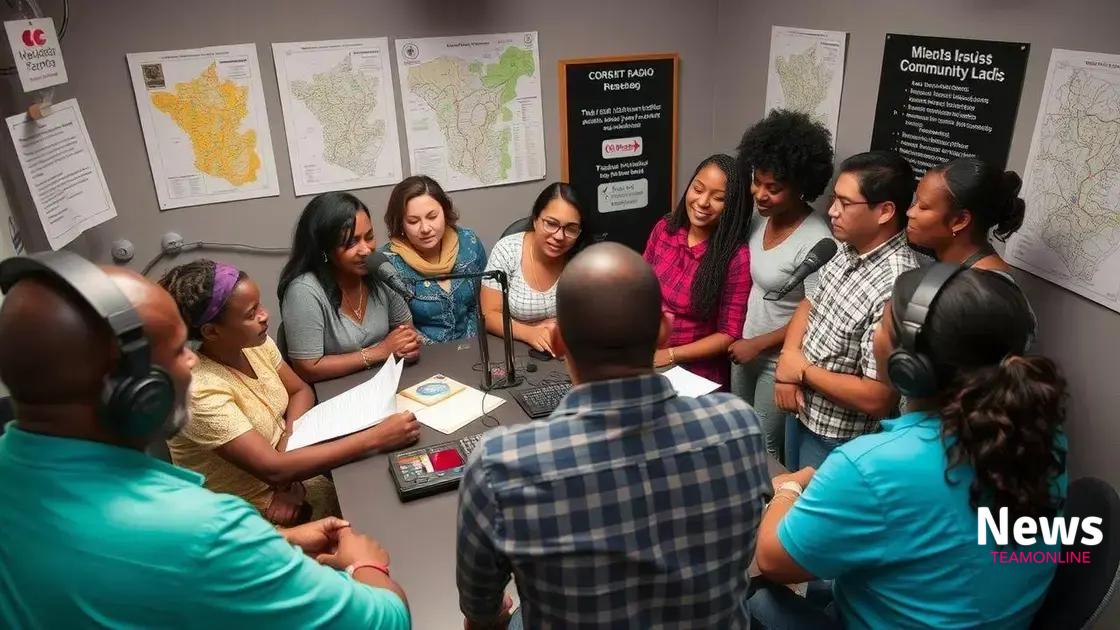Public radio protest series: What you need to know

The future of public radio in social movements involves leveraging technology and community engagement to provide real-time coverage and amplify diverse voices, ensuring important issues are effectively communicated and understood.
Public radio protest series showcases the crucial intersection of media and activism. Have you ever wondered how your local station covers emerging social issues? Let’s dive into the heart of this compelling dialogue.
Understanding public radio’s role in protests
Understanding the role of public radio in protests is essential to grasp how media shapes societal movements. Public radio serves as a platform for unheard voices and brings attention to crucial issues. With its commitment to community engagement, it has become a valued resource during protests.
The function of public radio
Public radio stations provide balanced news coverage that often highlights local protests. This role helps audiences understand the motivations behind movements. By giving air time to activists, public radio amplifies messages that might otherwise get overlooked.
Key contributions of public radio
- Delivering unbiased news and information.
- Hosting interviews with protest leaders.
- Promoting community discussions around social justice.
- Documenting historical and ongoing struggles.
With these contributions, public radio plays a crucial role in educating the public about the complex issues at stake. For example, during movements for racial equality, many stations aired documentaries that dived deep into the history and context of the protests. This approach not only informs but also engages the community.
Moreover, public radio often collaborates with local organizations to disseminate information on peaceful protests, enhancing visibility and participation. This partnership fosters a sense of civic responsibility among listeners. By tuning in, individuals can better understand their communities and the larger movements affecting their lives.
As protests evolve, so does the role of public radio. New formats, such as podcasts or social media engagement, allow stations to reach broader audiences, ensuring diverse voices are heard. This adaptability is vital in our fast-paced media landscape.
Key figures in the public radio protest series
Key figures in the public radio protest series play a significant role in shaping narratives around social movements. These individuals include journalists, activists, and local community leaders who contribute their voices and insights during critical moments of change.
Influential journalists
Many journalists from public radio establish credibility through thorough reporting. Their dedication to fair and comprehensive coverage helps audiences grasp the complexities of protests. By highlighting different perspectives, they encourage dialogue around important issues.
Some notable journalists have:
- Covered pivotal moments in civil rights movements.
- Reported on grassroots organizations fighting for change.
- Featured personal stories from protest participants.
- Engaged with community discussions on air.
These contributions build trust within communities, making public radio a reliable source for information and a platform for activism.
Activists’ perspectives
Activists also significantly impact the public radio protest series. By sharing their experiences, they humanize the struggles behind the protests. Their stories bring to light the dedication needed to advocate for social justice and community rights.
Through interviews and segments, activists can:
- Explain the motives behind their movements.
- Highlight key challenges they face.
- Share successes and efforts to mobilize others.
These narratives resonate with listeners, fostering empathy and helping to drive community engagement.
Alongside journalists and activists, local leaders often join public radio forums to discuss pressing social issues. These conversations provide insights into the ripple effects of protests on communities and encourage listeners to participate actively in social change.
By uniting diverse voices, the public radio protest series demonstrates the power of media in shaping public understanding. With the ongoing collaboration between journalists, activists, and community leaders, the cycle of activism and awareness continues to grow.
Impact of public radio on community awareness

The impact of public radio on community awareness is profound. By providing a platform for local issues and connecting listeners with vital information, public radio helps to inform and engage communities. This relationship is crucial, especially during times of social change.
Raising awareness of local issues
Public radio stations often focus on stories that matter to their communities. These stories reach listeners who might otherwise be unaware of ongoing challenges. Regular programming can feature interviews with community leaders, discussions on local policies, and updates on community events.
- Highlighting local nonprofit organizations and their missions.
- Exploring environmental issues affecting the community.
- Covering town hall meetings and public forums.
- Providing updates on local government decisions.
Through these methods, public radio encourages community members to become more active participants in societal issues, fostering a sense of shared responsibility.
Strengthening community ties
Public radio serves as a bridge that connects citizens with one another. By sharing local news and personal stories, listeners can identify shared experiences and issues. This connection enhances community ties, making people feel more invested in their surroundings.
Listeners often find a sense of belonging through programming that resonates with their values and experiences. Additionally, public radio invites feedback from the community, allowing listeners to voice their concerns and opinions. By engaging with the audience, stations can create a dialogue that reflects the community’s needs.
The role of public radio in educating citizens cannot be overstated. By offering informational segments about local resources, listeners learn about services available to them. This education empowers individuals to seek assistance and participate actively in their community.
Overall, the influence of public radio on community awareness is substantial. It fosters engagement, strengthens relationships, and elevates local voices. As communities continue to grow and change, the role of public radio in shaping that landscape remains vital.
How protests shape public radio narratives
Protests significantly shape public radio narratives. As movements arise, they create a demand for storytelling that reflects the experiences and concerns of those involved. Stations respond by amplifying these voices, leading to a dynamic shift in programming and coverage.
Adapting to current events
Public radio is known for its ability to adapt quickly to changing events. When a protest occurs, radio stations are often on the scene, engaging with participants and gathering firsthand accounts. This immediate response not only informs listeners but also provides a platform for activists to share their messages.
- Live coverage of rallies and events.
- Interviews with protest organizers.
- Reports on the impact of protests on local communities.
- Discussion segments featuring community feedback.
This adaptability highlights the important role that public radio plays in documenting social movements as they unfold, ensuring that essential stories reach the airwaves.
Shaping public discourse
Through coverage of protests, public radio shapes public discourse around critical issues. By providing in-depth analysis and diverse perspectives, stations encourage listeners to engage in conversations about the topics at hand. This discussion helps build a community informed about ongoing challenges and the actions being taken to address them.
Moreover, public radio often features commentary from experts, allowing for a broader understanding of the complexities surrounding protests. These narratives bring to light the broader implications of local issues, illustrating how they connect to national and global movements.
Additionally, public radio programming often includes segments that analyze past protests, drawing connections to current events. This historical context helps listeners understand how activism has evolved over time and how it continues to influence society today.
As protests continue to play a central role in shaping narratives, public radio remains committed to providing coverage that thoughtfully reflects the voices and experiences of those involved. By embracing these stories, public radio not only informs but also inspires action within communities.
Future of public radio in social movements
The future of public radio in social movements looks promising as technology evolves and communities demand more engagement. As listeners seek authentic and relevant content, public radio stations are adapting to meet these expectations.
Incorporating new technology
Advancements in technology are allowing public radio to expand its reach. Digital platforms and social media are essential tools for engaging audiences. Many stations now offer podcasts, live streaming, and interactive online content. These innovations make it easier for listeners to access information and join conversations.
- Interactive platforms for listener feedback.
- Utilizing social media for real-time updates.
- Collaborating with online activists and influencers.
- Offering podcasts focused on current movements.
By leveraging these tools, public radio can bring real-time stories and updates to listeners, helping them stay connected to ongoing social issues.
Community-led programming
As public radio continues to evolve, community involvement will play a critical role. Stations are increasingly collaborating with local organizations to develop content that reflects community needs. This collaboration ensures that diverse voices are heard and represented in discussions.
Engaging with community leaders allows stations to:
- Feature local initiatives and movements.
- Highlight grassroots organizations working for change.
- Encourage participation in civic discussions.
This type of programming not only empowers communities but also fosters a sense of ownership among listeners. As individuals see their stories represented, they are more likely to engage with the station’s content.
The future of public radio will also likely involve deeper exploration of intersectional issues. By addressing how various social movements intersect, stations can enrich public discourse and inform listeners about the complexity of these issues. Through analytical segments and expert commentary, public radio can provide a broader understanding of social dynamics.
With a commitment to adaptability and community engagement, public radio appears poised to remain a vital component of social movements. By embracing new technologies and inclusive storytelling, it can continue to inform, inspire, and mobilize listeners.
FAQ – Questions About the Future of Public Radio in Social Movements
How is public radio adapting to social movements?
Public radio is adapting by using new technologies, engaging with communities, and providing real-time coverage of social issues.
What role does community involvement play in public radio?
Community involvement helps public radio reflect the diverse voices of its audience, ensuring that local concerns are addressed and amplified.
How does technology enhance public radio’s outreach?
Technology allows public radio to expand its reach through digital platforms, social media, and podcasting, making content more accessible to listeners.
Why are intersectional issues important in public radio narratives?
Addressing intersectional issues enriches public discourse by illustrating how various social movements are connected and relevant to listeners.





